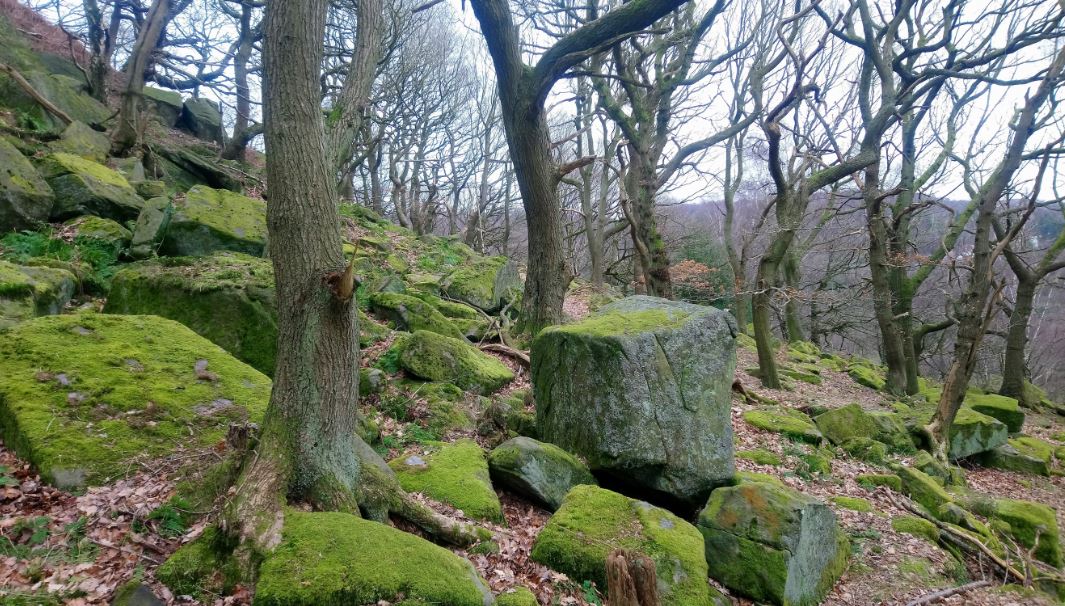Explore the meaning of trees in the Peak District
20 March 2019
Contemplate, be curious and have conversations about ‘The Meaning of Trees’ in a temporary woodland exhibition by artist Sarah Cook.
Being in the woods amongst trees can have so many different impacts on us. Some people find being amongst nature an experience of multi-sensory fulfilment, with its visual beauty, smells, sounds and touch. Others may focus on the yearly cycle of Spring growth and Autumn leaves or appreciate the practical resource in woods for burning, woodwork and various crafts. The geology and archaeology of local woodlands and uplands is of interest to many people.

Trees of the Peak District. Photo credit: Sarah Cook.
There is much concern about deforestation, habitat loss and pollution and the need for planting more trees and promoting plant diversity, as well as interest in science and botany such as new research about how trees communicate.
Some people are intrigued by mythologies concerning different types of trees and groupings of trees. For some, being amongst trees is a very personal experience, such as a feeling of being amongst friends, or a sense of ancestral and spiritual communing.
In this time of global warming, climate instability and the destruction of forests, it is apt to think about how and why trees are important to us, and how they impact on our lives and our actions. In the Peak District actions include schemes aimed at halting deforestation, planting and taking care of new native trees such as Woods for the Future The area is still seriously under forested compared to previous millennia and suffering from loss of habitats for animals, birds and insects.
Awareness of deforestation has energised me to focus on my own communion with trees where I live in the Peak District, opening myself to the associations and impacts trees have on me, interrogating what they mean to me.
‘The Meaning of Trees’ project arose from several observations and enquiries that became interwoven. One was a fascination with the tactile nature of autumn leaves as they fell into layer upon layer on the forest floor, became frayed and disintegrated over time. There is so much variety in the shapes and sizes of each leaf, so that each leaf is unique yet confirm to a pattern. This was particularly true of the leaves of oak trees that are so abundant up and around Padley Gorge in the Peak District. For the last three years I have been collecting fallen leaves and fashioning them in bronze, experimenting with lost wax casting methods and different types of patination.

Sarah’s art inspired by trees. Photo credit: Sarah Cook.
Together with the feel and look of leaves and tree bark, on daily walks through the local woods the trees have triggered images of bronze age peoples that lived in the Peak District, from around 2,500 BC. I imagined ancient beings, our ancestors, celebrating their festivals, with women as well as men wearing bronze torques, a mark of high status and power. Torques, or ‘torcs’, are neck collars often made of twisted or beaten gold but also cast in bronze. As there are no local examples of torques, I decided to create a composite design inspired by various museum held torques rather than make replicas.
My sculpture installation will attract people’s attention with 5 bronze pieces that will glint and shine in the changing light. Within the circle of trees, the torques (torcs) placed in the four cardinal directions (North, West, South and East). In the centre the fifth torque will top a large cloak made of 100 bronze oak leaves.

Torque-ing to trees? Photo credit: Sarah Cook
“The Meaning of Trees” theme aims is to engage people in a conversation about what trees and the landscape mean for them. During the event I will invite curiosity and contemplation in the woodland landscape, prompt conversations about what people feel is important about this local environment whilst celebrating its beauty and history, and draw attention to local initiatives to develop, conserve and manage woodland.
By Sarah Cook
Sarah Cook’s temporary exhibit on The Meaning of Trees can be seen in a woodland copse outside Brunt’s Barn (S32 2JA) near Grindleford Railway station and runs 30-31 March 2019 from 10am-4pm on both days. Everyone is welcome.
